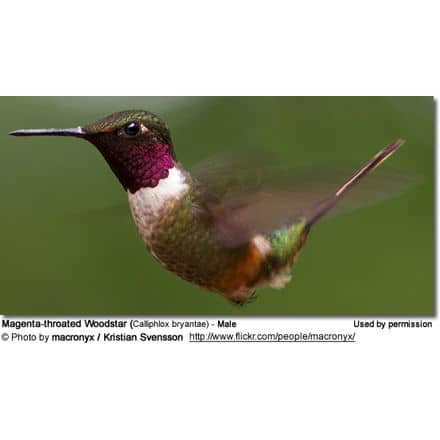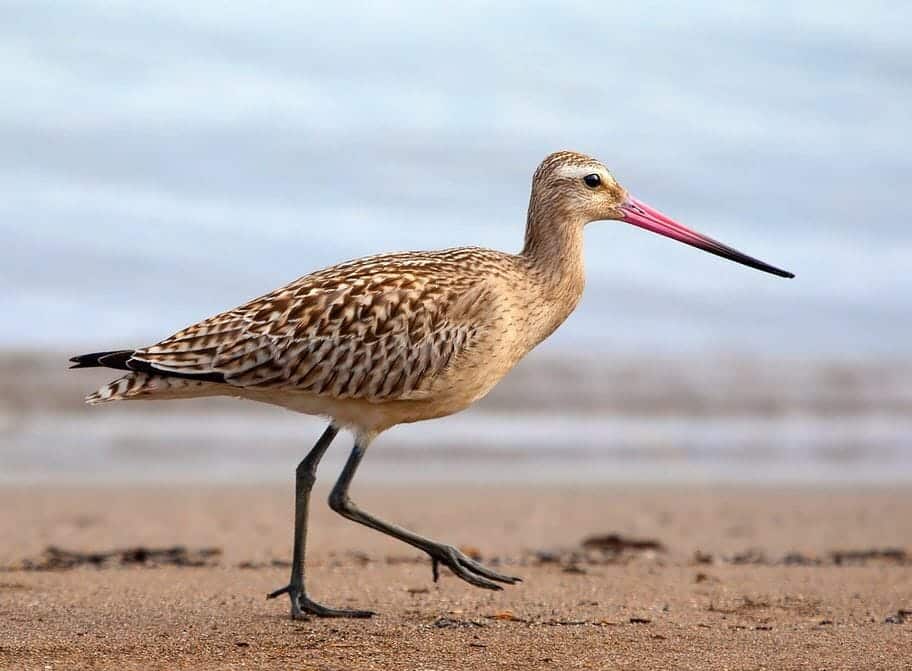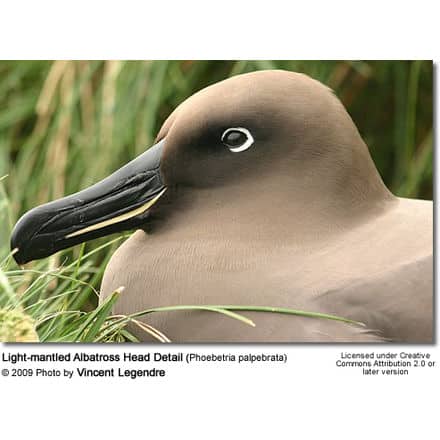Magenta-throated Woodstars
The Magenta-throated Woodstars (Calliphlox bryantae) – also known as Magena-throated Hummingbirds or Costa Rican Woodstars – are medium-sized, non-migratory (resident) hummingbirds that are found only in southern Central America.
Distribution / Habitat
Magenta-throated Woodstars occur naturally along the forest edges and scrub in Costa Rica and western Panama. They are restricted to the Pacific slope of the isthmus, where they are found along forest edges and scrub, at elevations from 2,300 – 6,100 feet (~ 700 -1,850 meters).

Description
The Magenta-throated Woodstars measure about 9 cm long in length and weigh about 3.5 g.
The male has a distinctive magenta throat separated by a white collar from the green chest and flanks. The back is green and the belly is rufous. He has white rump patches. The black-tipped tail is long and forked.
The female lacks the male’s long tail. Her plumage is generally like the male’s but her throat is grey-buff instead of magenta, and the tail sides are rufous.
Juveniles resemble the female, but the plumage below is paler and they have buff fringes to the upper plumage.
Similar Species:
They resemble the Bahama Woodstar (Calliphlox evelynae) but occur in different geographical areas.
Diet / Feeding
The Magnificent-throated Hummingbirds primarily feed on nectar taken from a variety of brightly colored, scented small flowers of trees, herbs, shrubs, and epiphytes.
They favor flowers with the highest sugar content (often red-colored and tubular-shaped) and seek out, and aggressively protect, those areas containing flowers with high-energy nectar. They use their long, extendible, straw-like tongues to retrieve the nectar while hovering with their tails cocked upward as they are licking at the nectar up to 13 times per second. Sometimes they may be seen hanging on the flower while feeding.
Many native and cultivated plants on whose flowers these birds feed heavily rely on them for pollination. The mostly tubular-shaped flowers actually exclude most bees and butterflies from feeding on them and, subsequently, from pollinating the plants.
In winter, when flowering plants may not be readily available, they may substitute their nectar diet by drinking the sap from holes created by sapsuckers. They may also visit local hummingbird feeders to feed on sugar water. They drink out of bird baths or water fountains where they will either hover and sip water as it runs over the edge; or they will perch on the edge and drink, just like all the other birds; however, they only remain still for a short moment.
They also feed on small spiders and insects – important sources of protein particularly needed during the breeding season to ensure the proper development of their young. Insects are often caught in flight (hawking); snatched off leaves or branches, or taken from spider webs. A nesting female can capture up to 2,000 insects a day.
Males establish feeding territories, where they aggressively chase away other males as well as large insects – such as bumblebees and hawk moths – that want to feed in their territory. They use aerial flights and intimidating displays to defend their territories.
Breeding / Nesting
Hummingbirds are solitary in all aspects of life other than breeding, and the male’s only involvement in the reproductive process is the actual mating with the female. They neither live nor migrate in flocks, and there is no pair bond for this species.
Males court females by flying in a U-shaped pattern in front of them – either alone or in competition with other males. He will separate from the female immediately after copulation. One male may mate with several females. In all likelihood, the female will also mate with several males. The males do not participate in choosing the nest location, building the nest, or raising the chicks.
The female is responsible for building the cup-shaped nest out of plant fibers woven together and green moss on the outside for camouflage in a protected location in a shrub, bush, or tree about 3m above ground often near the tip of a descending bamboo stem.
She lines the nest with soft plant fibers, animal hair, and feathers down, and strengthens the structure with spider webbing and other sticky material, giving it an elastic quality to allow it to stretch to double its size as the chicks grow and need more room. The nest is typically found on a low, thin horizontal branch.
The average clutch consists of two to three white eggs, which she incubates alone for about 15 – 19 days, while the male defends his territory and the flowers he feeds on.
The young are born blind, immobile, and without any down.
The female alone protects and feeds the chicks with regurgitated food (mostly partially digested insects since nectar is an insufficient source of protein for the growing chicks). The female pushes the food down the chicks’ throats with her long bill directly into their stomachs.
As is the case with other hummingbird species, the chicks are brooded only the first week or two and are left alone even on cooler nights after about 12 days – probably due to the small nest size. The chicks leave the nest when they are about 20 – 26 days old.
Calls / Vocalizations / Sounds
The males’ songs are described as spluttering gurgles, and their calls are dry chi or territorial chrrrrt.
Alternate (Global) Names
Chinese: ?????? … Czech: Kolibrík beloskvrnný, kolib?ík b?loskvrnný … Danish: Magentastrubet Skovjuvel … Dutch: Costaricaanse Boself … Finnish: Costaricanhankokolibri … French: Calliphlox bryantae, Colibri magenta … German: Magentakolibri, Magenta-Kolibri, Violettkehl-Sternkolibri … Italian: Silvistella golamagenta, Stella dei boschi golamagenta … Japanese: kosutarikahachidori … Norwegian: Magentakolibri … Polish: koliberek kostarykanski, koliberek kostaryka?ski … Russian: ???????????? ??????? … Slovak: cmelovec fuksínový, ?me?ovec fuksínový … Spanish: Colibrí Estrella de Garganta Violeta, Colibrí Magenta, Estrellita Gorgimorada … Swedish: Magentakolibri





